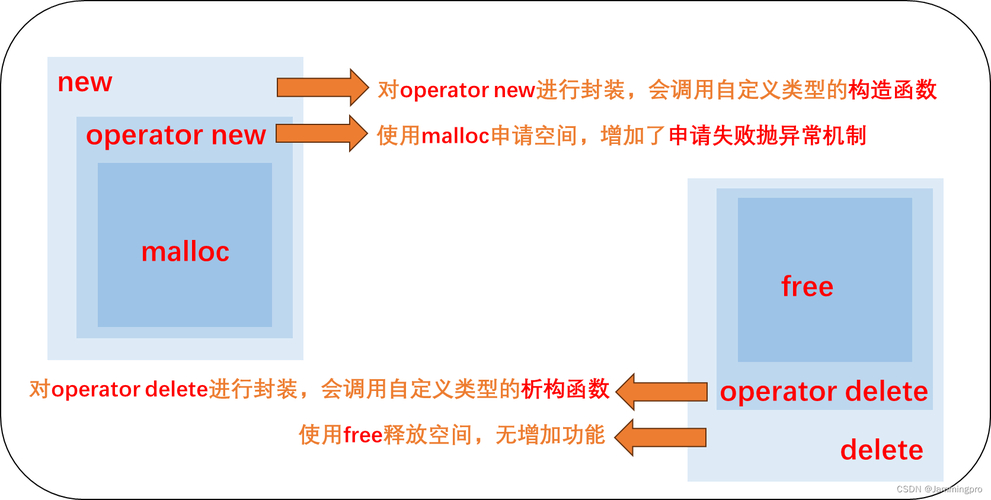- 作者:老汪软件技巧
- 发表时间:2024-12-07 21:06
- 浏览量:
前言
我们都知道我们写的代码是不允许发生内存泄露的,所以我们使用C/C++语言写代码时,学会合理的分配内存和释放内存是至关重要的。下面说说有哪些可以分配内存和释放内存的方式。
malloc是分配内存的函数,返回值是void*,所以需要手动的进行类型转换free是释放内存的函数,但是不会把指针置空,所以需要自己把指针赋值为NULL,否则会出现不可预估的问题。
#include new和delete
使用new分配内存会进行下面几个步骤步骤:1、分配内存空间2、调用构造函数3、返回正确的指针
使用delete释放内存会进行下面几个步骤步骤:1、调用析构函数2、释放内存3、指针置为nullptr
基本类型的分配内存
#include new分配内存失败的话,会抛出std::bad_alloc异常,所以我们可以这样编写代码
#include 自定义类型的分配内存
#include 
使用new和delete的注意事项有以下方面
1、new和delete必须成对使用,new和delete搭配使用,new[]和delete[]搭配使用
2、释放内存后,记得将指针置为nullptr,方式悬挂指针
3、不要多次释放内存,释放内存前记得判断是否不为nullptr才释放
4、使用指针前也需要判断是否不为nullptr才使用
上面的分配内存和释放内存都需要手动操作,稍微不小心就会忘记释放内存,或者释放内存错误,导致内存泄露,所以我们需要使用更安全的方式,智能指针,先学习shared_ptr和unique_ptr的用法
使用unique_ptr和shared_ptr
unique_ptr是独享所有权,不能被复制,只能被转移。使用于资源的独占管理的场景。shared_ptr是共享所有权,多个指针可以共同管理同一个对象,引用计数管理内存释放,当引用计数为0时,调用析构函数
#include myclass = make_unique();
//shared_ptr
shared_ptr myclass = make_shared();
myclass->Print();
/* //这个就不用了,离开作用域,自动调用析构函数
if(myclass != nullptr){
delete myclass;
myclass = nullptr;
}
*/
return 0;
}
使用week_ptr
week_ptr是用来解决shared_ptr循环引用问题的,那么,什么是循环引用呢?
#include 上面的代码就发生了循环引用的问题,当a和b离开作用域时,发现并没有调用析构函数,其实,从代码中就可以看出,当调用a的析构函数时,需要把a的成员变量b释放掉,而释放b就需要调用b的析构函数,而这是有需要把b的成员变量a释放掉,所以就进入了死循环。
解决这个问题,就需要到weak_ptr,因为weak_ptr不改变引用计数。只需把上面代码的其中一个shared_ptr改为weak_ptr即可,代码如下
#include 如果不确定写的代码是否有内存泄露问题,那么可以使用Valgrind等工具检测是否存在内存泄露。具体用法可以自行查资料。
总结:
1、内存管理:无论是使用malloc/free还是使用new/delete,都需要手动管理内存,所以一定要确保每个分配的内存得到正确并且及时的释放,避免内存泄露。
2、智能指针:推荐使用shared_ptr和unique_ptr来自动管理内存,大大减少内存泄露的风险。
3、内存泄露检测:可以借助例如Valgrind等工具检测内存是否泄露,可以及时发现问题。




